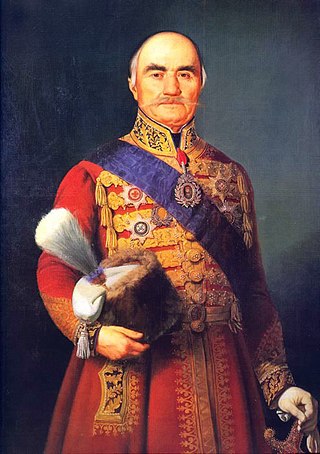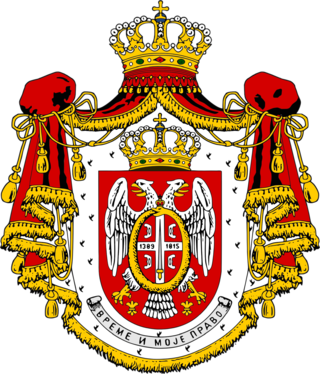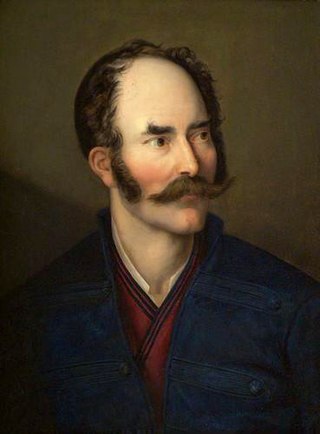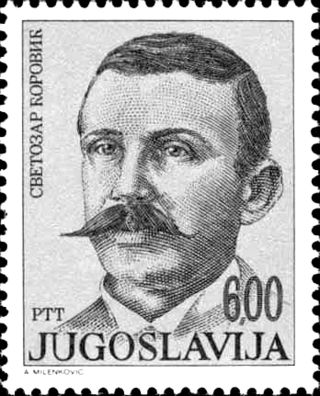Related Research Articles

Alexander Karađorđević was the prince of Serbia between 1842 and 1858 and a member of the House of Karađorđević.

Miloš Obrenović born Miloš Teodorović, also known as Miloš the Great was the Prince of Serbia twice, from 1815 to 1839, and from 1858 to 1860. He was an eminent figure of the First Serbian uprising, the leader of the Second Serbian uprising, and the founder of the House of Obrenović. Under his rule, Serbia became an autonomous principality within the Ottoman Empire. Prince Miloš was an autocrat, consistently refusing to decentralize power, which gave rise to a strong internal opposition. During his rule, Miloš the Great bought a certain number of estates and ships from the Ottomans and was also a prominent trader. Despite his humble background, he eventually became the most affluent man in Serbia and one of the wealthiest in the Balkan peninsula, possessing estates in Vienna, Serbia and Wallachia

The House of Obrenović was a Serbian dynasty that ruled Serbia from 1815 to 1842, and again from 1858 to 1903. They came to power through the leadership of their progenitor Miloš Obrenović I in the Serbian Uprising of 1815–1817 against the Ottoman Empire, which led to the formation of the Principality of Serbia in 1817. The Obrenović dynasty were traditionally allied with Austria-Hungary and opposed the Russian-supported Karađorđević dynasty.

Jovan Cvijić was a Serbian geographer and ethnologist, president of the Serbian Royal Academy of Sciences and rector of the University of Belgrade. Cvijić is considered the founder of geography in Serbia. He began his scientific career as a geographer and geologist, and continued his activity as a human geographer and sociologist.
Jovan is a Serbian male given name equivalent to English "John" or Slavic "Ivan", from Hebrew: יהוחנן.

Simeon "Sima" Milutinović "Sarajlija" was a poet, hajduk, translator, historian and adventurer. Literary critic Jovan Skerlić dubbed him the first Serbian romantist.

Revolutionary Serbia, or Karađorđe's Serbia, refers to the state established by the Serbian revolutionaries in Ottoman Serbia after the start of the First Serbian Uprising against the Ottoman Empire in 1804. The Sublime Porte first officially recognized the state as autonomous in January 1807, however, the Serbian revolutionaries rejected the treaty and continued fighting the Ottomans until 1813. Although the first uprising was crushed, it was followed by the Second Serbian Uprising in 1815, which resulted in the creation of the Principality of Serbia, as it gained semi-independence from the Ottoman Empire in 1817.

Svetozar Ćorović was a Bosnia and Herzegovina novelist. In his books, he often wrote of life in Herzegovina and, more specifically, the city of Mostar. His brother was Vladimir Ćorović, a distinguished Serbian historian who was killed in 1941 during World War II in Greece.

The Yugoslav volunteers in the Spanish Civil War, known as Spanish fighters and Yugoslav brigadistas, was a contingent of volunteers from the Kingdom of Yugoslavia that fought for the Republicans during the Spanish Civil War (1936–1939). An estimated 1,664 "Yugoslav brigadistas" fought in the war, out of whom c. 800 were killed in action. According to Spanish statistics, 148 Yugoslav volunteers received the officer rank during the conflict.

Belgrade City Administration was an administrative-security institution in Belgrade from 1839 to 1944. For most of that time, its headquarters was located in the notorious Glavnjača prison, on the present-day site of the University of Belgrade Faculty of Chemistry, on Students Square.

Jovan Ćulibrk, is a Serbian Orthodox prelate who is the current bishop of Pakrac and Slavonia of the Serbian Orthodox Church, from 2014. Before that, he was titular bishop of Lipljan between 1999 and 2014. Ćulibrk was an active music critic and author about rock and roll and pop culture.
References
- ↑ "International Migration and Development" . Retrieved 13 May 2016.
- ↑ "Migration profiles – Serbia" (PDF). UNICEF . Retrieved 20 August 2018.
- ↑ Original name in Czech is Miloš Eckert